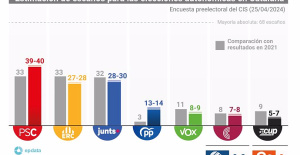Combining it with the discarding of the most unfavorable years could soften the fall and reduce the heterogeneity of pensions
MADRID, 14 Sep. (EUROPA PRESS) -
The extension of the period for calculating the regulatory base from 15 to 25 years, the current period, has led to a 5% reduction in the average initial pension, while an extension from 25 to 35 years would cause an additional decrease of 8.2 %, according to the study published this Wednesday by the Bank of Spain entitled 'Estimation of the impact of variations in the calculation period of the regulatory base on the amount of new retirement pensions'.
The body, which takes the 2019 pensions, points out that simultaneously extending the calculation period to 35 years with the discarding of the most unfavorable years to determine the regulatory base would allow smoothing the fall in the average initial pension, while reducing the heterogeneity of pensions. However, inequality would fall to a lesser extent than if the calculation period were restricted to 35 prior to the pension.
For example, the report indicates that taking into account the most favorable 29 years within the 35 years prior to retirement would result in a similar average pension (-0.1%) to that resulting from taking into account the 25 years prior to retirement. retirement.
In addition, the agency considers that this way of determining the regulatory base would produce, on average, an increase in the initial benefit of pensions that are below the median (with respect to a scenario in which the regulatory base is calculated at from 25 years prior to retirement) and a drop in the initial benefit for pensions in the fourth quartile of the distribution --the highest--.
"Extending the calculation period would have a heterogeneous impact among pensioners. In particular, the effect would be less for pensions below the median, which would result in less inequality," the agency highlights.
ESCRIVÁ DISCARDS A CALCULATION PERIOD OF 35 YEARS
Just this week, the Minister of Inclusion, Social Security and Migration, José Luis Escrivá, stated that, within the framework of the negotiation with the social agents to complete the pension reform that has already been resumed, he will propose, following the recommendations of the Pact de Toledo, how to help improve the fairness of the system when calculating the pension in the new professional careers, which are no longer the traditional ones.
In this sense, the minister, who has ruled out that the period taken into account to determine the amount of the pension will be extended from the current 25 years to 35 years, explained that, for one in three workers, the best years of contribution are no longer the last of their career, as was the case in traditional careers.
For this reason, and in order to improve the fairness of the system, he believes that "we must turn this around" and analyze with the social agents whether it is possible to act on the period for calculating the pension and at the same time "destroy the worst years of contribution" and give a better treatment to contribution gaps (periods in which there is no contribution due to not being employed).
EFFECT OF THE EXTENSION OF THE CALCULATION ON THE INITIAL PENSION
According to the study, the marginal effect of extending the calculation period by one year would increase in the number of years computed. For example, between 15 and 25 years, an additional year of the calculation period would reduce the initial pension by 0.5% on average, while, between 25 and 35 years, said average reduction would increase by up to 0.9%.
The report highlights that, under the change in the average initial pension indicated, as a result of the different calculation periods of the regulatory base, there is a high degree of heterogeneity underlying the different characteristics of the workers and their pension
In the first place, in terms of gender, the extension of the calculation period would affect the initial average pension of women and men in a similar way, although the negative effect would be somewhat greater for women in the case of the extension from 15 to 25 years, and somewhat higher for men in the event of an extension from 25 to 35 years.
In particular, the passage from 15 to 25 years would reduce the initial pension of women and men by 5.4% and 4.8%, respectively, while the increase from 25 to 35 years would be associated with an initial pension 8.1% and 8.3% lower for women and men, respectively.
Secondly, the increase in the calculation period of the regulatory base from 15 to 25 years would have a relatively less impact on the initial pension of workers with more than one year of contribution gaps or with more than one year of unemployment episodes during the 15 years prior to retirement.
In particular, the initial pension of workers with more than one year of contribution gaps and more than one year of unemployment would be reduced by 0.4% and 2.7%, respectively, compared to the 5% drop in the average initial pension of all discharges and 6.2% in the case of pensions for part-time workers.
The marginal effect of extending the number of years would be particularly high for the group of workers with more than one year of unemployment, so that an extension of the calculation period from 25 to 35 years would reduce their average initial pension by 7.8% .
Thirdly, there would also be a relevant heterogeneity in the result of extending the calculation period of the regulatory base by amount of the initial pension, estimated according to a calculation period of 15 years.
In particular, the average initial pension of the benefits of the first quartile would experience a smaller reduction, while that of the benefits of the third quartile would suffer a more intense reduction.
Specifically, extending the calculation period from 15 to 25 years would imply a fall of 0.5% and 7.7% in the average initial pension of the benefits of the first and third quartiles, respectively. To this would be added an additional reduction of 2.1% and 9.2%, respectively, if the calculation period were extended from 25 to 35 years.
In the case of the highest pensions, corresponding to the last quartile, the effect of extending the calculation period from 15 to 25 years would generate a reduction of the average initial pension of 4.7%, less than that observed in the pensions of the third quartile. However, the marginal effect of moving from 25 to 35 years for benefits in the fourth quartile would be more pronounced, since the average initial pension for benefits in that quartile would fall by 10.1%.
RESTRICT THE CALCULATION PERIOD TO THE MOST FAVORABLE YEARS
For its part, the possibility of discarding the most unfavorable contribution years for calculating the benefit could soften the fall in the average pension as a result of the extension of the calculation period.
In particular, compared to a scheme in which the 25 years prior to retirement were taken into account, the use of between the most favorable 25 and 28 years, within the 35 years prior to retirement, would yield an average initial pension higher, whereas, if the calculation period varied between the most favorable 30 and 34 years, the average initial pension would be lower.

 Exploring Cardano: Inner Workings and Advantages of this Cryptocurrency
Exploring Cardano: Inner Workings and Advantages of this Cryptocurrency Seville.- Economy.- Innova.- STSA inaugurates its new painting and sealing hangar in San Pablo, for 18 million
Seville.- Economy.- Innova.- STSA inaugurates its new painting and sealing hangar in San Pablo, for 18 million Innova.- More than 300 volunteers join the Andalucía Compromiso Digital network in one month to facilitate access to ICT
Innova.- More than 300 volunteers join the Andalucía Compromiso Digital network in one month to facilitate access to ICT Innova.-AMP.- Ayesa acquires 51% of Sadiel, which will create new technological engineering products and expand markets
Innova.-AMP.- Ayesa acquires 51% of Sadiel, which will create new technological engineering products and expand markets A Commission created by the CSD will supervise the RFEF
A Commission created by the CSD will supervise the RFEF The AN judge prosecutes the former ETA leader for her responsibility in the kidnapping and murder of Miguel Ángel Blanco
The AN judge prosecutes the former ETA leader for her responsibility in the kidnapping and murder of Miguel Ángel Blanco The European Parliament condemns the contacts of the Catalan independence movement with Russia and demands an investigation
The European Parliament condemns the contacts of the Catalan independence movement with Russia and demands an investigation The PSC would win the Catalan elections with 39-40 seats, Junts would obtain 28-30 and ERC 27-28, according to the CIS
The PSC would win the Catalan elections with 39-40 seats, Junts would obtain 28-30 and ERC 27-28, according to the CIS How Blockchain in being used to shape the future
How Blockchain in being used to shape the future Not just BTC and ETH: Here Are Some More Interesting Coins Worth Focusing on
Not just BTC and ETH: Here Are Some More Interesting Coins Worth Focusing on Retrópolis brings the golden age of video games and computing to the UPV
Retrópolis brings the golden age of video games and computing to the UPV Looking for video games that value the neighborhoods of Valencia
Looking for video games that value the neighborhoods of Valencia UPV researchers improve the efficiency of air conditioning systems using a geothermal heat pump
UPV researchers improve the efficiency of air conditioning systems using a geothermal heat pump València is committed to citiverse and smart tourism to be "the reference technological hub of the Mediterranean"
València is committed to citiverse and smart tourism to be "the reference technological hub of the Mediterranean" A million people demonstrate in France against Macron's pension reform
A million people demonstrate in France against Macron's pension reform Russia launches several missiles against "critical infrastructure" in the city of Zaporizhia
Russia launches several missiles against "critical infrastructure" in the city of Zaporizhia A "procession" remembers the dead of the Calabria shipwreck as bodies continue to wash up on the shore
A "procession" remembers the dead of the Calabria shipwreck as bodies continue to wash up on the shore Prison sentences handed down for three prominent Hong Kong pro-democracy activists
Prison sentences handed down for three prominent Hong Kong pro-democracy activists ETH continues to leave trading platforms, Ethereum balance on exchanges lowest in 3 years
ETH continues to leave trading platforms, Ethereum balance on exchanges lowest in 3 years Investors invest $450 million in Consensys, Ethereum incubator now valued at $7 billion
Investors invest $450 million in Consensys, Ethereum incubator now valued at $7 billion Alchemy Integrates Ethereum L2 Product Starknet to Enhance Web3 Scalability at a Price 100x Lower Than L1 Fees
Alchemy Integrates Ethereum L2 Product Starknet to Enhance Web3 Scalability at a Price 100x Lower Than L1 Fees Mining Report: Bitcoin's Electricity Consumption Declines by 25% in Q1 2022
Mining Report: Bitcoin's Electricity Consumption Declines by 25% in Q1 2022 Oil-to-Bitcoin Mining Firm Crusoe Energy Systems Raised $505 Million
Oil-to-Bitcoin Mining Firm Crusoe Energy Systems Raised $505 Million Microbt reveals the latest Bitcoin mining rigs -- Machines produce up to 126 TH/s with custom 5nm chip design
Microbt reveals the latest Bitcoin mining rigs -- Machines produce up to 126 TH/s with custom 5nm chip design Bitcoin's Mining Difficulty Hits a Lifetime High, With More Than 90% of BTC Supply Issued
Bitcoin's Mining Difficulty Hits a Lifetime High, With More Than 90% of BTC Supply Issued The Biggest Movers are Near, EOS, and RUNE during Friday's Selloff
The Biggest Movers are Near, EOS, and RUNE during Friday's Selloff Global Markets Spooked by a Hawkish Fed and Covid, Stocks and Crypto Gain After Musk Buys Twitter
Global Markets Spooked by a Hawkish Fed and Covid, Stocks and Crypto Gain After Musk Buys Twitter Bitso to offset carbon emissions from the Trading Platform's ERC20, ETH, and BTC Transactions
Bitso to offset carbon emissions from the Trading Platform's ERC20, ETH, and BTC Transactions Draftkings Announces 2022 College Hoops NFT Selection for March Madness
Draftkings Announces 2022 College Hoops NFT Selection for March Madness



























